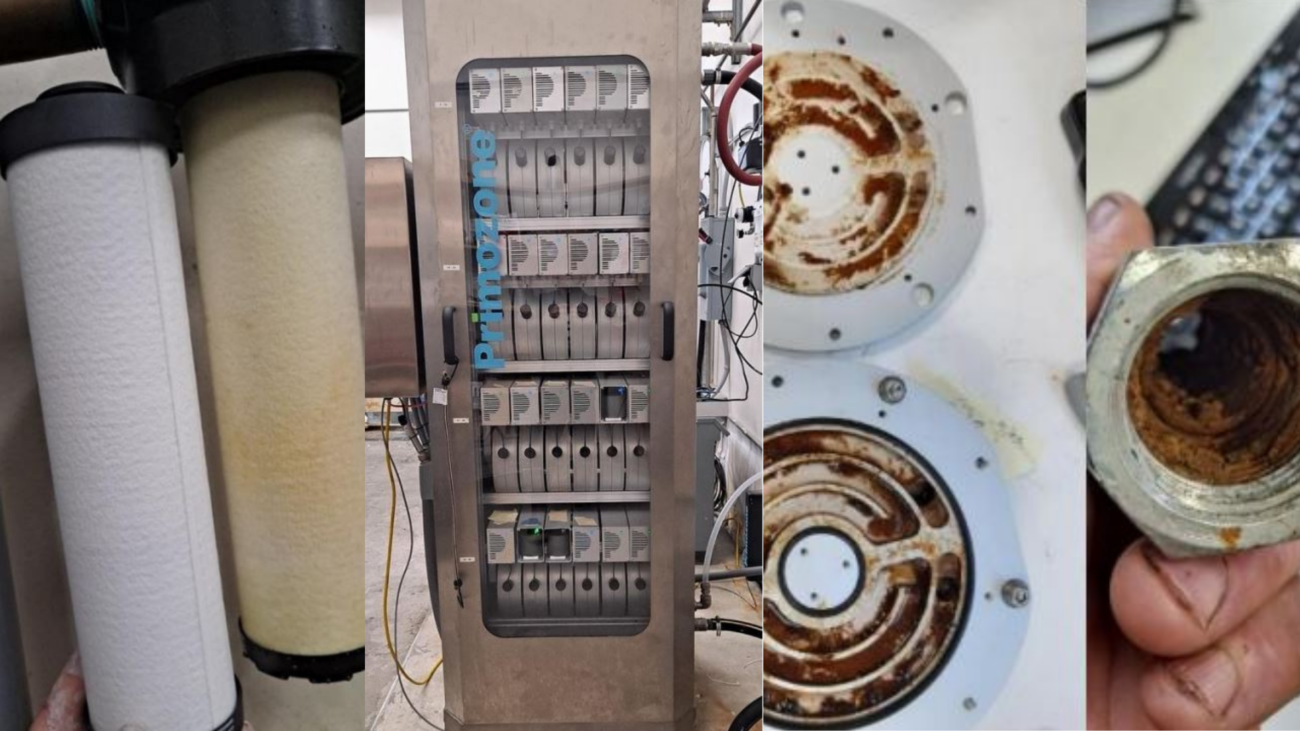
(Photos compiled from Public Works reports to the Assembly)
Wrangell’s troubled drinking water system needs a makeover, but the process of engineering and building a new plant is one that can take years.
That’s not soon enough to address some ongoing problems at the plant, says the community’s Public Works director, Tom Wetor.
“With our processing and working through for looking at a new plant, and the time that that has taken, and the notion that that could be two years out still, we do not feel this is an issue that we are able to wait two years before addressing,” Wetor told Wrangell’s Borough Assembly Tuesday (September 14).
Of top concern to city officials is one of the first steps in the process of moving Wrangell’s drinking water from open-water reservoirs through the plant and to the tap: ozonation.
Ozone — three oxygen molecules bound together — is used at the beginning of the water treatment process to kill bacteria and viruses, as well as remove metals from the water. But the air compressors that help create the ozone are failing, and one of the plant’s two ozone generators isn’t functioning properly either. Public works officials say they can’t figure out why.
Replacing the air compressors and other oxygen generation equipment would cost about $150,000, according to the company that manufactures the machines. Altogether, fixing the whole ozone system could cost triple that (Wetor estimates it would be about $445,000) — which would essentially wipe out the reserves in Wrangell’s water fund, which currently has about $490,000.
Wetor says the state Department of Environmental Conservation mandates reducing and removing contaminants from drinking water in a series of steps called a log reduction, where each log step makes the water cleaner. In Wrangell, it’s a four-log process.
“Ozone is step one, one log; [the] roughing filter [is step] two; slow sand filter three and lastly chlorination to meet our four log removal requirements,” Wetor says.
More chlorine is added as the water heads out into the pipes, too. That combats any pollutants that might be in the pipes. Extra chlorine isn’t an issue unless other steps in the process aren’t working, Wetor says.
“If we have enough ozone loss, it will start to impact our log removal,” Wetor explains. “Put simply, turbidity and organic loading will go up. If that goes up, that will require us to increase the chlorine dosage before it goes into the distribution system.”
But increasing the chlorine would bump up against another one of Wrangell’s major water problems: disinfection byproducts that can cause cancer over a long period of exposure. The byproducts are formed when chlorine interacts with leftover bits of organic matter in treated drinking water.
Wrangell’s drinking water was over the regulatory limit for a class of disinfection byproducts called H-A-A-5s last year, and the city administration committed to interim water treatment measures and testing to get the levels back on track.
So far, that’s worked. In June and July, Wrangell’s water quality testing showed that disinfection byproducts were well within state regulatory limits.
August test results are expected at the end of the month. Last year, the community’s August water testing pushed it out of compliance, since increased rain and runoff in the fall is often tied to an increase in the amount of dirt and other debris in Wrangell’s water.
Plant operators say the ongoing issue with disinfection byproducts, as well as issues with water flow, would be solved with a new plant. But that’s a few years out, and the fact remains, something has to be done about the air compressors and the ozone generators in the meantime.
It’s a tough pill to swallow, city manager Lisa Von Bargen told the assembly. Wrangell has a lot of pressing projects.
“I often say [we have] a quarter of a billion dollars in maintenance and infrastructure needs for Wrangell,” Von Bargen said. “About 100 million of that is water. Of course, that includes the reservoirs [which is a $50 million project]. But, we are nowhere — I mean, we’re not even in the realm of reality in terms of what our reserves should be to handle that kind of infrastructure.”
Wrangell’s assembly has yet to decide exactly which steps they’ll take to address the current problems at the water plant, while working on obtaining an updated cost estimate for a new water plant.
City officials have stated on multiple occasions that paying for a new water plant could cause the local water rate to increase by at least $10 a month — a 30% increase from the current residential rate of $32.28 monthly. They haven’t said how much it would cost Wrangell ratepayers to upgrade part or all of the ozone system at the water plant.
9/17/2021: This article has been updated to clarify the cost of oxygen generation equipment, which includes air compressors.
Get in touch with KSTK at news@kstk.org or (907) 874-2345.









